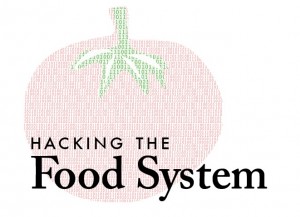[Due to the overwhelming response to our series Hacking the Food System, Food+Tech Connect will be continuing the conversation each Wednesday with a new post from a thought leader in the field. Read past posts exploring how technology, information and data can change the food system status quo and follow along as the conversation continues on Twitter (hashtag #foodtech), or Facebook.]
Our food system is not broken- it is poorly designed.
Currently food moves from farm to fork linearly across a supply chain designed to maximize investor ROI. This linear design results in a long list of things that are bad for our economy, health, and environment. Food costs are on the rise, as are obesity and diabetes. Food recalls, environmental pollution, and food insecurity are all far too common. The system clearly needs to be re-engineered to better serve the needs of everyone involved.
But before thinking about redesign, we need to really understand how the current system works. Doing so requires the ability to examine the different pieces of the system and supply chain, something currently impossible given the proprietary nature of the food and agriculture industries.
Herein lies the major roadblock and opportunity- hacking the food system requires creating incentives to move from closed, proprietary approaches to open ones.
Design informed by comprehensive data, rather than the biased interests of any one actor, is a better starting point than the current R&D infrastructure supports. Again, this will only be realized if the food and agriculture industries have incentives to share more information about how they do business. Much like the tools being developed by IBM, Cisco, GE, and others that capture and use data to fundamentally redesign cities, health care, energy, education, financial markets among other things, we need tools to network and analyze our food system.
How do you re-imagine the architecture of the food supply chain when its blueprints are locked up in proprietary databases?
Statups. A growing number of startups such as Real Time Farms and Foodtree are hacking the system to meet people’s growing demand for more information about who and how their food is produced. They are crowdsourcing previously unavailable data and packaging it in a format that helps consumers make more informed food choices.
Others such as Yummly, Food Genius, Open Menu, and a group of us working on a Foodshed Open Data Standard are developing standards, formats, and ontologies for structuring various kinds of food data, making it easier to access, gain insights from, and share.
Developers like John Mertens at Code for America are developing API’s for USDA data, transforming it into a format others can easily build upon. And these are just a few examples- other startups are beginning to develop new farm management tools and distribution platforms.
These entrepreneurs are both opening up information and doing the hard work of figuring out how the system works to ensure they build products that solve problems.
We rely on multi-national corporations, policy makers, marketers, scientists, lobbyists, investors, and NGOs to architect our food supply chain. Now, the web is democratizing food, allowing you and me to develop a networked infrastructure for innovation. Let’s get hacking!
Related articles
- Beth Hoffman on Hacking the Food System: New “Technology” in Agriculture (foodandtechconnect.com)
- Hilary Mason on Hacking the Food System: The Story of the Ultimate Cookie (foodandtechconnect.com)
- Nicola Twilley on Hacking the Food System: Crowdsourcing What & Where Angelenos Eating (foodandtechconnect.com)
- Bo Fishback on Hacking the Food System: It’s Different This Time (foodandtechconnect.com)
- Elizabeth McVay Greene on Hacking the Food System: Farm Profitability and Affordability of Food (foodandtechconnect.com)
- Anthony Nicalo on Hacking the Food System: Eliminating Information Asymmetry (foodandtechconnect.com)
- Ali Partovi on Hacking the Food System: Focus on the Supply Chain (foodandtechconnect.com)
- Nevin Cohen on Hacking the Food System: The Networked Future of Urban Agriculture (foodandtechconnect.com)
- Carl DiSalvo on Hacking the Food System: Reinvent Ag-Tech (foodandtechconnect.com)
- Ellen Gustafson on Hacking the Food System: Eat Your Veggies (foodandtechconnect.com)





